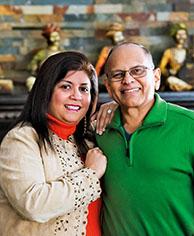A Passion for Connecting
Ani Chitaley ScD ’68 and Suzana Naik

A conversation with Ani Chitaley about his involvement with MIT quickly reveals his deep fondness for the Institute. Five decades after completing his doctorate in mechanical engineering, he remains closely connected to MIT and its wider community of faculty, students, and alumni.
Chitaley, who currently runs an investment management consultancy, has had a varied and successful career in engineering, investment management, and entrepreneurship that he says was only made possible by his MIT education.
Chitaley has long given back to MIT through modest annual donations and “intellectual involvement” such as hosting knowledge-sharing seminars and attending classes and other events on campus. By 2007, his thinking about the Institute’s role in his life crystallized, and so he decided to become more focused in his support of MIT through planned giving. A gift annuity that will support the mechanical engineering faculty was a reflection of his gratitude for the role MIT has played in his life. “Just three years at MIT created an invaluable and powerful foundation for my life,” says Chitaley. “Not just in my professional life, but as a foundation for a way of living.” Chitaley hopes that his gift will play a part in helping MIT continue to innovate new ways of thinking for future generations of students and faculty. Choosing a gift annuity was also a wise investment for Chitaley, as it will provide a fixed annual income for life.
Underpinning his enthusiasm for MIT is a lifelong passion for learning and technology. “I love dabbling, and I love technology,” he says. “That’s all I’ve ever wanted to do with my life.” When Chitaley was in high school, the Sputnik satellite launch had him and his generation “looking toward the sky and to the stars.” And as a young graduate student studying mechanical engineering at the Indian Institute of Technology (IIT) Bombay, Chitaley learned about MIT and dreamed of one day studying at the Institute and making the US his home. Thanks to a research assistantship from MIT, Chitaley’s dream became a reality, and he was part of the first wave of Indian science and technology students who came to the US for advanced studies.
Although his degree from IIT Bombay was not recognized in the US, Chitaley had no hard feelings about redoing some masters-level courses at MIT. Instead, he was enthusiastic because his MIT coursework exposed him to an entirely new way of thinking. “The whole-systems thinking I learned at MIT became so fundamental to my goals and intellectual growth that I still use it for everything I do,” says Chitaley. “It literally has become part of every cell in my body.”
After completing his doctorate in 1968, Chitaley pursued several careers in India and the US before ultimately deciding on investment management. In the early 1980s, he revisited his fascination with the space age as an aerospace engineer and consultant with Booz Allen Hamilton, creating solutions to complex problems using the systems thinking approach he learned at MIT.
“The whole-systems thinking I learned at MIT became so fundamental to my goals and intellectual growth…. It literally has become part of every cell in my body.”
In one recollection, Chitaley describes solving a problem with the ablative insulation on NASA’s space shuttle fuel tank while consulting with Martin Marietta (now Lockheed Martin). His mathematical model revealed that proportioning the ingredients by volume, and not by weight, was the right way to ensure consistent results—a simple solution to a seemingly complex problem that he says was made possible only by the MIT approach.
He later brought his expertise to investment management, joining Fidelity Investments’ mutual fund division. There he was tasked with a number of challenges, including revamping and improving the performance of the trading floor operations. Once again, Chitaley drew on lessons learned at MIT to solve the challenge. “The basis of my thinking came from a systems control course that I had taken at MIT,” he explains. “We created an industry-leading solution that saved Fidelity’s mutual fund shareholders almost a billion dollars by way of higher-quality trades.”
Based in the Boston area, Chitaley enjoys returning to campus frequently to meet with faculty and students whose work interests him. Family ties have also kept him close to MIT. His son, Raaj Chitaley, is a 1995 graduate, and his first wife, Shubha, who passed away in 2006, once worked as a technician at the MIT Nuclear Reactor Laboratory. Chitaley credits his second wife, Suzana Naik, a senior corporate finance executive, with encouraging him to continue to explore creative ways to give back to MIT.
Looking forward, Chitaley and Naik have multiple other areas of interest with MIT. They would like to help create a way for MIT alumni and students to connect and collaborate intellectually, “to keep MIT firmly in the hearts of alumni, worldwide.” The couple would also like to get involved with other student research for interdisciplinary projects in orthotics/robotics research to assist people with mobility challenges.
“We want to continue supporting MIT in whatever way we can,” says Chitaley. “If you look at the Institute’s contributions to society, human life, and global economics, they are priceless.”
